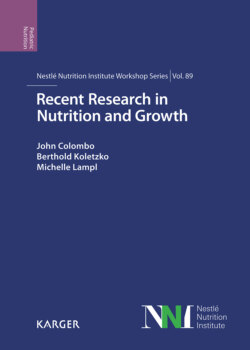Читать книгу Recent Research in Nutrition and Growth - Группа авторов - Страница 28
На сайте Литреса книга снята с продажи.
Structure
ОглавлениеMorphologically, the growth plate is characterized by a strikingly high degree of anisotropy. Axially, the chondrocytes (of which it is composed) are organized into orderly vertical columns, which represent the functional units of longitudinal bone growth [6]. Laterally, the activities of the chondrocytes are synchronized, which gives rise to a distinct horizontal stratification (Fig. 2a) [7]. Three layers are distinguishable, which are referred to as the resting, proliferative; and hypertrophic zones, which reflect the functions of the cells therein. From the epi- to the metaphyseal aspects of the bony shaft, the life span of an individual chondrocyte is reenacted in each of the vertical columns of cells, with each horizontal zone representing an activity phase through which it passes.
In the superficial resting zone, the chondrocytes undergo slow, nonsymmetrical mitotic division, which accounts for its earlier designation as the “stem cell” zone. The daughter cells thereby produced feed the adjacent zone of proliferation, in which the chondrocytes undergo rapid symmetrical mitotic division, which occurs in a direction that runs perpendicular to the longitudinal axis of the bone. In the proximal tibial growth plate of “prepubertal” rats, the duplication of a cell is achieved within a time span of about 54 h [6]. After the completion of mitosis, the two daughter cells, which lie side by side at this juncture, become reorganized one above the other [8], which is realized by a directional resorption and neoproduction of the intercellular matrix [9] (for illustration in a short video, see Aszodi et al. [10]). This reorientation of the cells, which leads to their axial alignment, is a precondition for the strictly controlled axial growth of the bone [10]. The process depends upon a number of factors, not least amongst which is an intact extracellular matrix. If the turnover of the extracellular matrix is disturbed, longitudinal growth will be impaired. This is the case in many genetic diseases, such as achondroplasia [11]. The role of specific extracellular-matrix molecules in the process of cellular reorientation can be investigated by their targeted deletion in knockout mice [10, 12, 13]. Certain dietary and environmental toxins that compromise specific enzymatic activities in the extracellular matrix of cartilaginous tissue can also disturb the matrix-dependent reorientation of chondrocytes and, in due course, the longitudinal growth of the bones [14, 15].
After the cells have undergone a limited number of mitotic divisions, this proliferative activity ceases, and the chondrocytes begin to enlarge rapidly as well as to produce more extracellular matrix. By means of this process of controlled phenotypic modulation, which occurs in the zone of hypertrophy, the longitudinal growth of the bones is rapidly achieved in a very efficient manner. At a late phase of hypertrophy, the vertical septa between the columns of cells undergo calcification. The matrix compartments that surround the chondrocytes (pericellular matrix) and bind them together in the columnar stacks (territorial matrix) (Fig. 2b) are excluded from this process of mineralization [1].
At the end of the phase of rapid hypertrophy, which lasts no longer than about 48 h in the proximal tibial growth plate of “prepubertal” rats [6], the chondrocytes at this juncture on the vascular invasion front are still viable and active. Thereafter, they are rapidly eliminated (within 2–3 h), probably by a process of active killing, by ingrowing macrophages which also degrade the unmineralized cartilaginous matrix [16]. Some investigators deem the terminal chondrocytes to be eliminated by a process of apoptosis or degeneration [17]. However, the great speed at which the terminal chondrocytes are eliminated argues in favor of the cell killing hypothesis [16, 18]. Such a mechanism is indeed operative during the remodeling of bone [19, 20]. This process involves the active destruction and elimination of osteocytes by osteoclasts during the drilling of channels through the cortical bone, whereby arise the haversian canals.
The lower portion of the hypertrophic zone is distinguished as a separate zone of mineralization by some investigators [21]. Earlier, this region was referred to as the zone of degeneration, which was believed to represent the final stage in the life cycle of a chondrocyte. However, the degenerative appearance of the terminal chondrocytes in the lower portion of the hypertrophic zone has since been shown to be an artifact of chemical fixation [16, 22].
The cartilage of the growth plate gives way to the metaphysis at the front of vascular invasion. In this region, the chondrocytes and unmineralized cartilaginous matrix are continually eliminated by macrophages and replaced by primary trabeculae of the metaphyseal bone [23, 24]. About 60% of the calcified longitudinal septa of the cartilaginous tissue are eliminated by osteoclasts. The remaining 30% serve as seeding substrata for the deposition of osseous tissue and thus as the tracks along which the primary trabeculae of bone elongate [3]. Hence, the importance of the strictly axial alignment of the vertical columns of cells in the growth plate [9, 25].
